I’ll confess. I have a thing for chocolate. It’s a lifelong obsession that began with M&Ms and Hershey’s Kisses when I was a kid. In the last few years, I’ve honed it down to a few squares of 70% dark chocolate after dinner (and maybe after lunch too.)
I usually have one of the big brands. They’re easy to get, inexpensive and tasty. But I know there’s a world of specialty bars out there – small batch bean-to-bar chocolate with provenance – that offer unique flavor. They’re the grand cru of chocolate bars.
I want to taste them all.
But even for a chocolate hound like me, that’s a daunting prospect. Instead, I gathered a few friends to help me out: Myriam, who hails from Belgium where they know something about chocolate; Pat, who’s eyes lit up when I mentioned the prospect of a tasting; and Gregg, a booze and beer writer with an extensive tasting background.
I asked Laura Downey, cheesemonger and owner of The Fairfield and Greenwich Cheese Companies, to lead the discussion and suggest some bars to taste. She’s into chocolate too and has a rack of colorfully-packaged artisanal chocolate bars by the register. Marsha and I rounded out the group. We gathered after hours at the store in Fairfield around the table where they hold their popular Cheese School classes.
The bars we tasted ranged from the ubiquitous Lindt Excellence, $3.30 to Amedei Porcelana from Tuscany for an eye-popping $20 for 1.75 oz. Eight bars in all from around the world, some are widely available and some are in limited supply.
Chocolate, like coffee, is usually not processed where it is grown. Manufacturers source their fermented and dried beans from growing regions around the globe and apply their individual chocolate philosophy and technique to get a signature flavor. The big guys use commodity beans, the small houses are more choosy about their sources.
The bars we sampled came from both supermarkets and the artisanal collection that Downey features. Bars range in size from 50g (1.75 oz) to 3.5 oz. As the price goes up, the bars get smaller. I don’t dare calculate the price per pound. All were 70% cocoa.
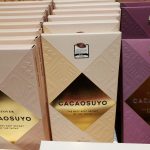 In the order we tasted they were: Cacaosuyo, Lakuna ($10) from Peru where the founders wanted to be near the source of high quality beans;
In the order we tasted they were: Cacaosuyo, Lakuna ($10) from Peru where the founders wanted to be near the source of high quality beans;
Lindt, Excellence ($3.30) a widely available international brand that includes vanilla and soy lecithin in addition to the usual ingredients of just cocoa and sugar;
Goodnow Farms, Esmeraldas ($15) from Ecuador, hand-made on a small farm in Sudbury, MA by Tom and Monica Rogan from single estate beans;
Pump Street Chocolate, Crayfish Bay Organic Estate, Grenada ($11) made in Suffolk, England from beans grown in the Caribbean;
Green and Black’s, Organic ($4) from Trinitario beans, a widely available international brand which also includes some vanilla;
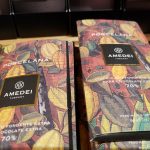 French Broad, India ($12) from Asheville, NC with beans from the Anamalai family farm in Southern India. (Bean-to-bar makers Dan Rattigan and Jael Skeffington got hooked while living in the chocolate growing region of Costa Rica);
French Broad, India ($12) from Asheville, NC with beans from the Anamalai family farm in Southern India. (Bean-to-bar makers Dan Rattigan and Jael Skeffington got hooked while living in the chocolate growing region of Costa Rica);
Endangered Species, Bold and Silky Dark ($3.30) a big store brand which contributes 10% of their profits to wildlife conservation. It too includes vanilla.;
Amedei Porcelana from Tuscany, the most expensive bar ($20) in the tasting, made in Italy from small production Criollo beans grown and processed under the family’s supervision.
Before we started our blind tasting, Downey gave us a few tips. The color should be even but may vary
from brand to brand. Look for a glossy surface with no white bloom. Take in the aroma and then let the chocolate melt on the tongue before chewing. Flavors will develop over a few minutes and should linger in a long finish.
Each brand was unique. While tasting, we exchanged comments on the experience one bar at a time. In a few cases, there was immediate agreement pro or con; other times the reactions were diverse. At the end, after chatting and re-tasting, I asked everyone to name their top two or three.
The overall favorite was Goodnow Farms, Esmeraldas. We all found it to be distinctive – lively and notably fruity. I thought dark fruits, maybe plums; Myriam found notes of banana; and Pat commented on the delicate fruit flavors. Laura liked the smooth mouthfeel and Gregg the long finish. After the reveal, Laura told us that Goodnow presses their own cocoa butter. That may make the difference.
A close second was the Bold and Silky from Endangered Species. Myriam called it smoky and viscous and Pat echoed that, saying it was a thick melt which reminded her of hot chocolate. Gregg noted a dry finish with good chocolate character. I thought it was chocolaty, bold, and assertive. A great bargain at $3.30, but there is added vanilla and lecithin which enhances the flavor and mouthfeel.
The Lindt Excellence was a distant third. Chocolaty, sweeter, smooth, and lots of flavor were some of the comments. This has been my house brand for a while. It’s everyday price ($3.30) is appealing, but it doesn’t have the complexity and depth of some of the small production bars.
Cacaosuyo (light berry fruit, a bit rough), Green and Black’s (full flavor, fruit, creamy) and French Broad (fruity, creamy, nice melt) all got one or two votes.
Pump Street (coffee, roasty, like baking chocolate) and Amedei Porcelana (tannic, not smooth, winey) didn’t have any champions.
The big brands did surprisingly well. Their popular easy-eating flavor profiles have a broad range of appeal. The small-production bars are more challenging but potentially a more rewarding experience.
I feel the need to defend the Amedei Porcelana. It was the most expensive and had a great provenance. Just as with wine, cheese or coffee the one most appreciated by experienced tasters may not be accessible to everyone. Laura pointed out that it was the favorite of the most chocolate-knowledgeable member of her staff.
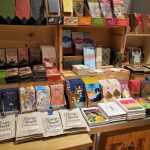 The good news is, there’s a lot of interesting, flavorful, carefully made chocolate out there. Like wine, there are popular-priced brands and richer, more complex bars for special occasions. Pat summed it up, “There are many different tastes and textures, colors, and lingering flavors. I feel as though I am on the kindergarten level of chocolate tasting.”
The good news is, there’s a lot of interesting, flavorful, carefully made chocolate out there. Like wine, there are popular-priced brands and richer, more complex bars for special occasions. Pat summed it up, “There are many different tastes and textures, colors, and lingering flavors. I feel as though I am on the kindergarten level of chocolate tasting.”
Frank Whitman can be reached at NotBreadAloneFW@gmail.com.







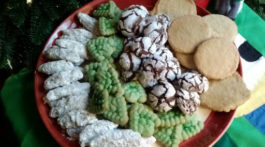
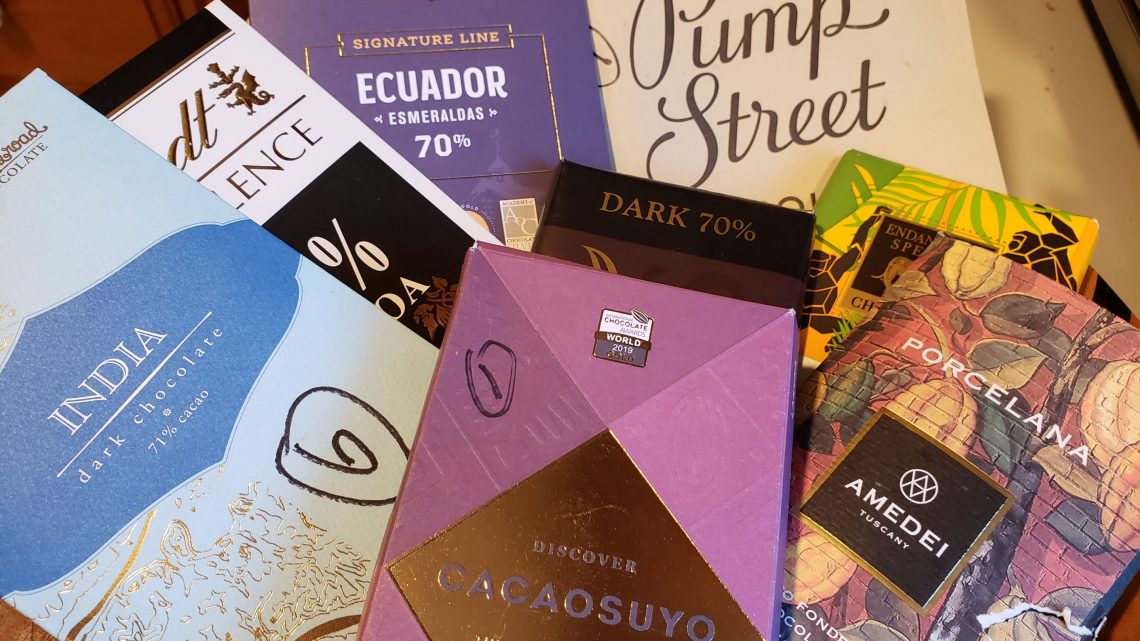

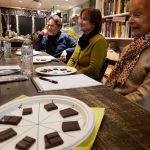


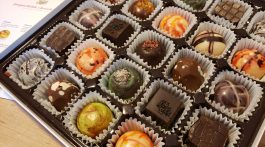
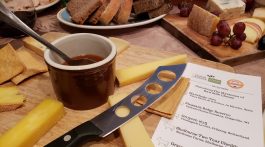
No Comment